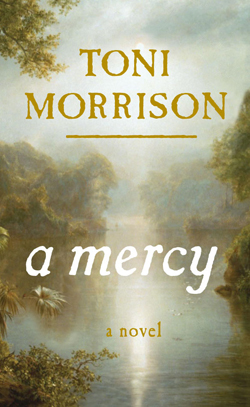
The Shape of Mercy is a rather simple story, told from the viewpoint of Lauren Durough, a college sophomore born into affluence. Her family’s money has afforded her many luxuries that she freely discloses at every turn, yet each casual mention of this inventory is coated with disdain. Lauren feigns rebellion, such as opting for a dorm room at UC-Santa Barbara in lieu of a condo at Stanford, and she readily—and frequently—applauds herself for choosing to live among the commoners. But to those who live paycheck to paycheck and struggle to survive, Lauren’s meager acts of rebellion are reminiscent of those of the hippies of the 60s and 70s, who could afford to spend their days fighting "The Man" and finding themselves because Mom and Dad were footing the bill.
One such mutinous decision finds our quasi-protagonist applying for a job transcribing the diary of Mercy Hayworth, an 18-year-old woman accused of bewitching her peers during the frenzy of the Salem witch trials. Lauren’s boss, Abigail Boyles, is a direct descendent of the diary’s author, and thus guards her familial treasure like an overprotective mother. The eccentric, crotchety Abigail hires Lauren specifically because she, too, is an only child borne into great wealth. What she ultimately needs from Lauren is two-fold: to give Mercy’s diary entries a place in history, and to help her peel back the layers of guilt that have suffocated her for most of her life. A tall order for a sheltered college student, indeed.
The problem with Meissner’s novel is that she fails to develop any of the characters beyond Mercy into ones that the reader should care about for longer than it takes to get through the book. Even Lauren’s supposed transformation rings hollow because its catalyst is no more believable than those who set it in motion. Her moral compass, appearing in the form of weak working-class stereotypes, are Esperanza, Abigail’s loyal Hispanic housekeeper; Clarissa, her working-two-jobs-to-put-herself-through-school roommate; and Raul, the devilishly good-looking medical-student love interest who is poor now but probably won’t be in the future. The first two routinely admonish Lauren for viewing life through green lenses while perched up high, languishing among The Haves. But, when the opportunity presents itself—Esperanza’s gifted condo and Clarissa’s salmon steak served on a silver platter by the Durough’s pool—both jump at the chance to abandon The Have-Nots. And Raul? Well, he remains devilishly good-looking and, like in all fairytales, rides in at sunset to save the day a la Prince Charming. How apropos for the princess.
The Shape of Mercy’s story-within-a-story would be worth a read if it was not mired in clunky dialogue (what’s with all the exclamation points?) and an uninteresting primary plot. What Meissner should have done was expand Mercy’s story and keep the parallels strictly between her and Abigail’s lives; both characters are strong enough and mysterious enough to hold the reader’s attention. Juxtaposing the younger woman’s naïveté with the older woman’s wisdom would have eliminated the need for pointless references to modern day materialism and added depth to the reading experience.
--Dianha Simpson
imagineatrium.com









































